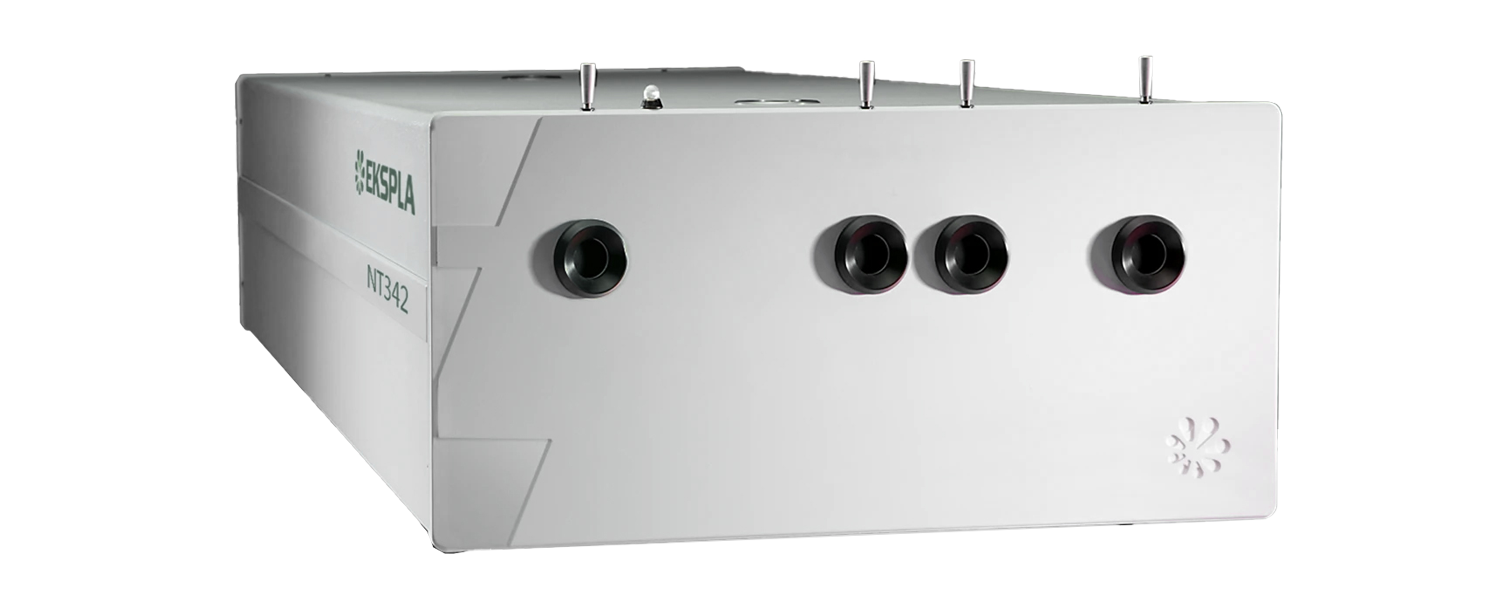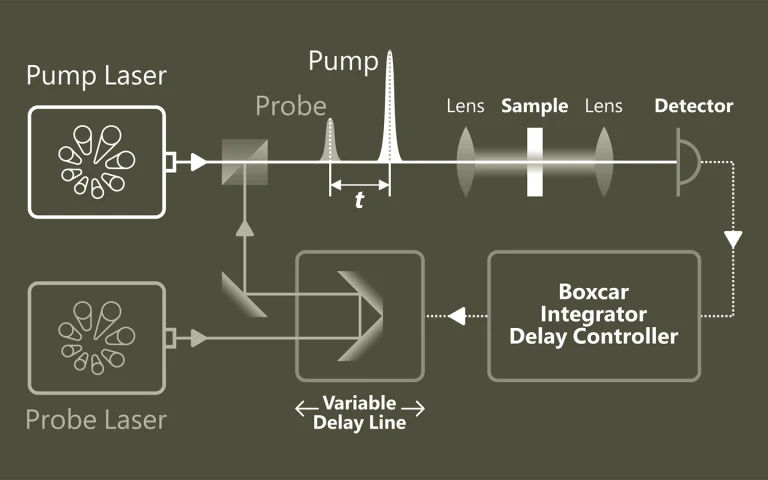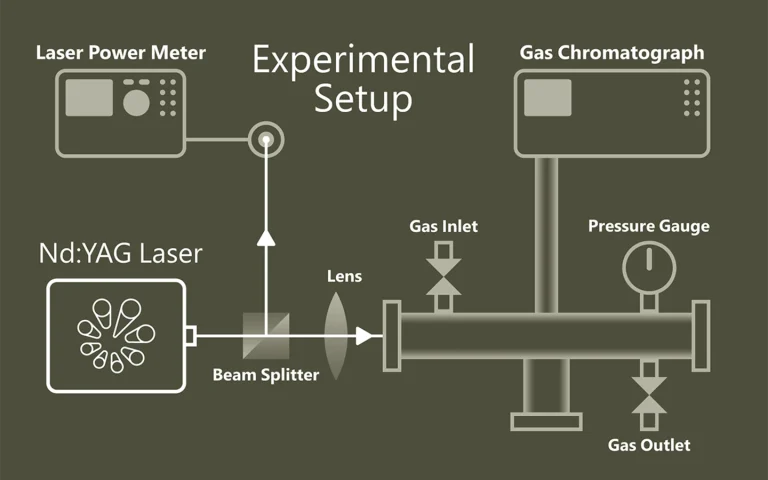NT340
Nanosekundenlaser mit hoher Pulsenergie und großem Abstimmbereich
Der NT340 ermöglicht softwaregesteuerte, lückenlose Abstimmung von 192 nm bis 4400 nm mit einer Wiederholrate von bis zu 20 Hz – alles aus einem einzigen Gerät. Mit einer Linienbreite von weniger als 5 cm⁻¹ und einer großen Auswahl an Optionen ist dieser Laser eine ausgezeichnete Wahl für ein sehr breites Spektrum spektroskopischer Anwendungen.

Features
- Softwaregesteuerte, lückenlose
- Wellenlängenabstimmung von 192 bis 4400 nm
- Bis zu 90 mJ Pulsenergie im sichtbaren Spektralbereich
- Bis zu 15 mJ Pulsenergie im UV-Spektralbereich
- Bis zu 20 mJ Pulsenergie im MIR-Spektralbereich
- 3–5 ns Pulsdauer
- Bis zu 20 Hz Pulswiederholrate
- Optional separater, gemeinsamer Ausgangsport für 532/1064 nm Strahl (separater Ausgangsport für den 355 nm Strahl ist Standard)
- Überwachung der OPO-Pumplaserenergie
- Hermetisch versiegelter Oszillatorkavität schützt nichtlineare Kristalle vor Staub und Feuchtigkeit
Anwendungen
- Laserinduzierte Fluoreszenz (LIF)
- Blitzlicht-Photolyse (Flash-Photolyse)
- Photobiologie
- Fernerkundung (Remote Sensing)
- Zeitaufgelöste Spektroskopie
- Nichtlineare Spektroskopie
- Vibrationsspektroskopie
- Cavity Ring-Down Spektroskopie (CRDS)
- Cavity Ring-Down Laser-Absorptionsspektroskopie (CRLAS)
- Infrarotspektroskopie (IR-Spektroskopie)
- Gasspektroskopie
Anwendungen

Pumpen. Proben. Verstehen
Die Pump-Probe-Spektroskopie ermöglicht einen tiefen Einblick in ultraschnelle Prozesse auf atomarer und molekularer Ebene. Mithilfe von gepulsten Lasern lassen sich dynamische Veränderungen mit extrem hoher zeitlicher Auflösung verfolgen. Typische Anwendungen liegen in der Untersuchung von Ladungsträgerdynamik in Halbleitern, der Analyse von Elektronentransfer in chemischen Reaktionen sowie der Erforschung lichtinduzierter Phasenübergänge in Materialien.

Wenn Licht Moleküle trennt
Photolyse beschreibt die lichtinduzierte Spaltung chemischer Verbindungen und spielt eine zentrale Rolle in der Photosynthese durch Wasserspaltung. Die Laser-Flash-Photolyse nutzt kurze, intensive Laserpulse (ns–fs), um kurzlebige Zwischenprodukte wie Radikale oder angeregte Zustände zu erzeugen und deren zeitlich aufgelöste Absorption zu beobachten. Probe-Pulse erfassen Reaktionsverläufe. Der Einsatz von OPOs erweitert die Möglichkeiten spektroskopischer Untersuchungen deutlich.
Anwendungen
Wissenschafliche Veröffentlichungen
Photogeneration and reactions of benzhydrylcations and radicals: A complex sequence ofmechanisms from femtoseconds tomicroseconds
C. F. Sailer, and E. Riedle, Pure and Applied Chemistry 85 (7), 1487-1498 (2013). DOI: 10.1351/PAC-CON-13-04-01.
Benzhydryl radicals and cations are reactive intermediates central to the under-standing of organic reactivity. They can be generated from benzhydryl halides by UV irradi-ation. We performed transient absorption (TA) measurements over the range from femto –seconds to microseconds to unravel the complete reaction scheme. The 290–720-nm proberange allows the unambiguous monitoring of all fragments. The appearance of the radical isdelayed to the optical excitation, the onset of the cation signal is found even later. Ab initiocalculations show that this non-rate behavior in the 100 fs range is due to wavepacket motionfrom the Franck–Condon region to two distinct conical intersections. The rise of the opticalsignal with a quasi-exponential time of 300 fs is assigned to the planarization and solvationof the photoproducts. The bond cleavage predominantly generates radical pairs. A subse-quent electron transfer (ET) transforms radical pairs into ion pairs. Due to the broad inter-radical distance distribution and the distance dependence, the ET is strongly non-exponen-tial. Part of the ion pairs recombine geminately. The ET and the recombination are terminatedby the depletion of close pairs and diffusional separation. The remaining free radicals andcations undergo further reactions in the nanosecond to microsecond regime.
Luminescence upconversion in colloidal double quantum dots
Z. Deutsch, L. Neeman, and D. Oron, Nature Nanotechnology , 649-653 (2013). DOI: 10.1038/nnano.2013.146.
Luminescence upconversion nanocrystals capable of converting two low-energy photons into a single photon at a higher energy are sought-after for a variety of applications, including bioimaging and photovoltaic light harvesting. Currently available systems, based on rare-earth-doped dielectrics, are limited in both tunability and absorption cross-section. Here we present colloidal double quantum dots as an alternative nanocrystalline upconversion system, combining the stability of an inorganic crystalline structure with the spectral tunability afforded by quantum confinement. By tailoring its composition and morphology, we form a semiconducting nanostructure in which excited electrons are delocalized over the entire structure, but a double potential well is formed for holes. Upconversion occurs by excitation of an electron in the lower energy transition, followed by intraband absorption of the hole, allowing it to cross the barrier to a higher energy state. An overall conversion efficiency of 0.1% per double excitation event is achieved.
Electronic spectroscopy and nanocalorimetry of hydrated magnesium ions [Mg(H2O)n]+, n = 20–70: spontaneous formation of a hydrated electron?
T. Taxer, M. Ončák, E. Barwa, C. van der Linde, and M. K. Beyer, Faraday Discuss. 217, 584-600 (2019). DOI: 10.1039/C8FD00204E. C. Kjær, and S. B. Nielsen, Phys. Chem. Chem. Phys. 21, 4600-4605 (2019). DOI: 10.1039/C8CP07340F.
Hydrated singly charged magnesium ions [Mg(H2O)n]+ are thought to consist of an Mg2+ ion and a hydrated electron for n > 15. This idea is based on mass spectra, which exhibit a transition from [MgOH(H2O)n−1]+ to [Mg(H2O)n]+ around n = 15–22, black-body infrared radiative dissociation, and quantum chemical calculations. Here, we present photodissociation spectra of size-selected [Mg(H2O)n]+ in the range of n = 20–70 measured for photon energies of 1.0–5.0 eV. The spectra exhibit a broad absorption from 1.4 to 3.2 eV, with two local maxima around 1.7–1.8 eV and 2.1–2.5 eV, depending on cluster size. The spectra shift slowly from n = 20 to n = 50, but no significant change is observed for n = 50–70. Quantum chemical modeling of the spectra yields several candidates for the observed absorptions, including five- and six-fold coordinated Mg2+ with a hydrated electron in its immediate vicinity, as well as a solvent-separated Mg2+/e− pair. The photochemical behavior resembles that of the hydrated electron, with barrierless interconversion into the ground state following the excitation.
